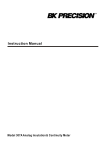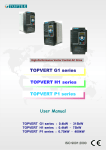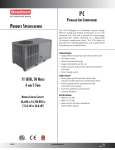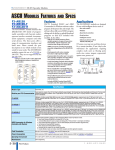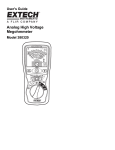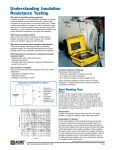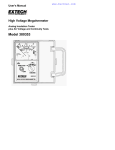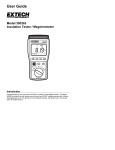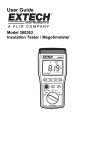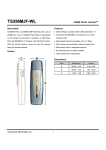Download User Manual_ET-809 manual_Ver_0
Transcript
ET-809 Insulation-Continuity Tester User Manual Wavecom Instruments Insulation-Continuity Tester User Manual Index Safety Precautions....................................................... 1-2 Safety Notes................................................................ 3 Features....................................................................... 3-4 Connections................................................................. 4 Specifications............................................................... 5 Why Test is Necessary................................................. 6 Instrument Layout........................................................ 7 Simplified Instructions.................................................. 8-9 Preparation for Measurement...................................... 9 Functions..................................................................... 10-16 Battery & Fuse Replacement....................................... 17 Calibration & Servicing................................................ 17 Cleaning & Storage..................................................... 17 Page 2 Wavecom Instruments Insulation-Continuity Tester User Manual 1. Safety Precautions Electricity can cause severe injuries even with low voltages or currents. Therefore it is extremely important that you read the following information before using your analogue tester. 1.1 This Instrument must only be used and operated by a competent trained person and in strict accordance with the instructions. Wavecom will not accept liability for any damage or injury caused by misuse or non compliance with instructions and safety procedures. 1.2 This instrument must not be used on live circuits. Ensure all circuits are de-energised before testing. See paragraph 1.8 for details of built-in warning features should your analog insulation tester be connected to a live system. 1.3 Never open your analogue insulation tester except for battery replacement. (see battery replacement section) 1.4 Always inspect you analog insulation tester and test leads before use for any sign of abnormality or damage. If any abnormal conditions exist (broken test leads, cracked case, display faulty etc...) do not attempt to take any measurement or use the tester. Return your analogue insulation tester to your nearest distributor for service. 1.5 Never replace the protective fuse with any other than the specified or equivalent 1.6 Your analogue insulation tester has been designed with your safety in mind. However, no design can completely protect against incorrect use. Electrical circuits can be dangerous and / or lethal when a lack of caution or poor safety practice is used. Page 3 Wavecom Instruments Insulation-Continuity Tester User Manual Use with caution in the presence of voltage above 24V as these pose a shock hazard. 1.7 Pay attention to cautions and warnings which will inform you of potentially dangerous procedures. 1.8 Your analogue insulation tester has a live circuit warning beeper. If it is connected to an AC live circuit, a beep of twice the frequency of the voltage present will be heard. DO NOT proceed to test and immediately disconnect the instrument from the circuit. In addition, the warning light will illuminate if the voltage is above 100Vdc or 70Vac. When AC voltage is present, before testing, it's value is displayed on the AC scale. Page 4 Wavecom Instruments Insulation-Continuity Tester User Manual 2. Safety Notes Rated environmental condition (1) Indoor use. (2) Installation Category Ⅲ. (3) Pollution Degree 2. (4) Altitude up to 2000M. (5) Relative humidity 80% Max. (6) Ambient temperature 0°C~40°C. Meter is protected throughout by double insulation or reinforced insulation. Warning ! risk of electric shock. Caution ! refer to this manual before using the meter. 3. Features ● High quality taut band movement. ● Three insulation test voltages: 1250Vdc 100MΩ 2500Vdc 200MΩ 31000Vdc 400MΩ ● Two continuity test on "Low Ohms": 1500Ω 23Ω ● Small and Lightweight. ● AC voltmeter with linear scale up to 500Vac. ● 205mA continuity short circuit current. ● 1mA test current on insulation test at nominal voltage. ● Automatic discharge of capacitance and inductive circuit off charge stored in the circuit under test.. Page 5 Wavecom Instruments Insulation-Continuity Tester User Manual ● Live Warning and display of external voltage presence. ● Fuse and overload protected. ● On line battery monitoring shows if battery is ok. ● Very low battery consumption. ● On-Load battery check (+/-205mA load for worst case). ● Operates on 8 dry batteries AA, R6P type. ● Mirrored scale for easy and accurate reading. ● Push and turn locking switch for long and hand free testing. ● Supplied with high quality test leads. ● Meets: LVD IEC/EN 61010-1 EMC EN 61326-1:2006 CLASS B EN 61326-1:2006 EN 61000-4-2:2001 EN 61000-4-3:2007 4. Connections Page 6 Wavecom Instruments Insulation-Continuity Tester User Manual 5. Specifications INSULATION ● Test Voltage 250Vdc 500Vdc 1000Vdc +10%-0% +10%-0% +10%-0% ● Mirror scale 100MΩ 200MΩ 400MΩ ● Mid-Scale 1MΩ 2MΩ 4MΩ ● Scale Multiplier x1/2 x1 x2 ● Accuracy ±5% ● Output short-circuit current ±1.3mA ● Regulated output voltage (up to 1mA current) 263.5V 525V 1052V CONTINUITY ● Low Ω:3Ω / 500Ω ● Test leads / fuse zero Ω adjustment by knob. ● Output short-circuit current:205mA ● Accuracy:±1.5% of scale length AC VOLTAGE ● Range:0 - 500Vac ● Accuracy:±3% of scale length GENERAL ● Voltage Warning:Warning light circuit live illuminate from 90Vdc/70Vac. Buzzer beep from 24Vac/dc. ● Battery Check:Battery Check indicate good batteries from 8Vdc to 13Vdc during a load test of 205mA. ● Battery OK:Battery OK Led illuminate from 8Vdc and is operative while testing. ● Power Source:1.5V(AA) x 8 ● Dimension:175(L) x 85(W) x 75(H)mm Weight:Approx. 650g (battery included) ● Accessories include: Test leads Fuse (0.5A/500V 5x20mm) Carrying case Instruction manual Batteries. Page 7 Wavecom Instruments Insulation-Continuity Tester User Manual 6. Why Test is Necessary? INSULATION Every electrical apparatus and installation need to be safe for the user and for the equipment itself. Electrical conductors of electricity need to be insulated from each other, so that they do not create electrical hazard or unnecessary consumption. Badly insulated circuits can create leakage current which can be dangerous and trip your GFCI, RCCB or ELCB. Each country regulates these levels at which the insulation is acceptable. Generally, insulation resistance measurements are done between each conductor and the earth, and between each conductors. CONTINUITY Checking the continuity of wires, complete circuits, connections, closure of contacts, circuit breakers, fuses, bounding resistance of connections, etc... are all very important. Page 8 Wavecom Instruments Insulation-Continuity Tester User Manual 7. Instrument Layout 1.Test Button Switch 2.Function Selector 3.Battery OK indicator 4.Mirror Scale 5.Live Circuit Warning Light 6.Test Leads and Fuse Zeroing Knob Page 9 Wavecom Instruments Insulation-Continuity Tester User Manual 8. Simplified Instructions INSTRUCTIONS ANALOGUE INSULATION-CONTINUITY TESTER WARNING This instrument must only be used by a competent trained individual. Consult the full operating instructions. Never press the test button before connecting test leads to circuit to test. INITIAL CHECKS 1. Switch to "Batt. Check" and depress the test button. If the pointer does not move to "BAT.OK", the battery needs to be replaced before proceeding. 2. Connect test leads to instrument, switch to 3Ω. Press and turn the test button (continuous mode), short the test leads. The pointer should swing from infinite towards zero. If not, the test leads or fuse (0.5A fast acting ceramic) maybe faulty. INSULATION TESTS MΩ RANGES 1. Select the desired insulation test voltage range, 250V, 500V, or 1000V. 2. Connect the leads to the instrument and circuit under test. 3. Check the circuit is not LIVE. 4. Press the test button. Read the red MΩ scale directly for 500V, multiply by 0.5 (or divide by 2) for 250V and multiply by 2 for 1000V. Page 10 Wavecom Instruments Insulation-Continuity Tester User Manual CONTINUITY TESTS - Ω RANGES 1. Select the desired ohm range, 3Ω or 500Ω. 2. Short the test leads, press test button and adjust the ohms zero ADJ to zero the pointer on the 0Ω (green scale). 3. Check the circuit is not LIVE. 4. Connect the test leads to the circuit under test. Press the test button. Read the selected range directly. GENERAL ● For AC voltmeter, do not press the test button, this is the default mode of the instrument. ● AC voltmeter operates without batteries. ● Insulation or continuity mode: for continuous operation, press and turn the test button. SAFETY PRECAUTION ● The circuit must not be LIVE, conduct initial checks first. If at any time , the "LIVE" circuit light is illuminated, or the warning buzzer sounds - DO NOT PROCEED, the circuit is live. ● Using the instrument in Insulation Mode may leave the Circuits charged up if test leads are removed too quickly. Avoid this by releasing the test button while the test leads are still connected to the circuit for a few seconds. 9. Preparation for Measurement Before testing Always check the following. At Power "ON", check that Bat. OK led illuminate and check that there is no visual damage to the Instrument or test leads. Check the test Leads continuity: 1. Connect the leads to the Instrument. 2. Zero the test leads while on the 3 ohm range. 3. This will indicate that the continuity of the test leads is Ok. 4. Verify that the test leads insulation is in good condition. Page 11 Wavecom Instruments Insulation-Continuity Tester User Manual 10. Functions 10.1 Battery Check Turn the function selector to Batt. Check. This function has a load which draw about 205mA when test is performed, and therefore it is doing a worst case battery test. Then, press the test button, the pointer should be in the BAT.OK area. During the test, the bat. OK Led (on line battery check) must illuminate if the pointer is in the BAT.OK area. Page 12 Wavecom Instruments Insulation-Continuity Tester User Manual 10.2 DC Warning The DC warning buzzer will beep continuously when DC voltage is higher than 30Vdc on the test probes and the test button is not pressed. The neon light "circuit live" will illuminate when the voltage on the test probes is higher than 90Vdc and the test button is not pressed. 10.3 AC Warning The AC warning buzzer will beep continuously when AC voltage is higher than 20Vac on the test probes and the test button is not pressed. The neon light "circuit live" will illuminate when the voltage on the test probes is higher than 65Vdc and the test button is not pressed. 10.4 AC Measurement The AC measurement is automatic on this instrument. As soon as AC voltage is present on the test leads, the instrument will display the AC voltage from 20 to 500Vac on the linear scale. Page 13 Wavecom Instruments Insulation-Continuity Tester User Manual 10.5 Low Ohms Measurement 0 - 500Ω Always check for voltage before testing and measuring on a circuit. This instrument is intended for measuring Low Ω and Insulation resistance on un- energized circuits only. Use the procedure explained at points 10.2, 10.3, 10.4. The first procedure to follow, is to zero the test leads II and II the fuse resistance. The instrument is equipped with a Zero Ω Knob. First, short circuit the test leads by connecting them together, then, press the test button and adjust the zero Ω knob until the pointer is precisely on the "0" of the 500Ω scale.Use the mirror scale to be precise with the pointer. Page 14 Wavecom Instruments Insulation-Continuity Tester User Manual Connect the test leads to the circuit to be measured. For short test, press button and keep pressed. For long test or hand free measurements, press and turn the test button. 10.6 Low Ohms Measurement 0 – 3Ω Always check for voltage before testing and measuring on a circuit. This instrument is intended for measuring Low Ω and Insulation resistance on un-energized circuits only. Use the procedure explained at points 10.2, 10.3, 10.4. The first procedure to follow, is to zero the test leads and the fuse resistance.The instrument is equipped with a Zero Ω Knob. First, short circuit the test leads by connecting them together, then, press the test button and adjust the zero Ω knob until the pointer is precisely on the "0" of the 3Ω scale. Use the mirror scale to be precise with the pointer. Page 15 Wavecom Instruments Insulation-Continuity Tester User Manual Connect the test leads to the circuit to be measured. For short test, press button and keep pressed. For long test or hand free Measurements, press and turn the test button. 10.7 Insulation Resistance Measurement @ 250Vdc Always check for voltage before testing and measuring on a circuit. This instrument is intended for measuring Low Ω and Insulation resistance on un-energized circuits only. Use the procedure explained at points 10.2, 10.3, 10.4. Check the test leads and fuse resistance by zeroing the test leads and fuse as per the 7.6 procedure. Connect the test leads to the circuit to be measured and wait for a few seconds. The instrument will automatically discharge any remaining energy which could be present on the circuit, and will check for voltage at the same time. Page 16 Wavecom Instruments Insulation-Continuity Tester User Manual Once you are sure that the circuit to be tested is not energized, then press the button for a short test duration or press and turn the button for a long test.Once you end the test, allow a few seconds for the Instrument to automatically discharge the circuit. 10.8 Insulation Resistance Measurement @ 500Vdc Always check for voltage before testing and measuring on a circuit. This instrument is intended for measuring Low Ω and Insulation resistance on un-energized circuits only. Use the procedure explained at points 10.2, 10.3, 10.4. Check the test leads and fuse resistance by zeroing the test leads and fuse as per the 7.6 procedure. Connect the test leads to the circuit to be measured and wait for a few seconds. The instrument will automatically discharge any remaining energy which could be present on the circuit, and will check for voltage at the same time. Page 17 Wavecom Instruments Insulation-Continuity Tester User Manual 10.9 Insulation Resistance Measurement @ 1000Vdc Always check for voltage before testing and measuring on a circuit. This instrument is intended for measuring Low Ω and Insulation resistance on un-energized circuits only. Use the procedure explained at points 10.2, 10.3, 10.4. Check the test leads and fuse resistance by zeroing the test leads and fuse as per the 7.6 procedure. Connect the test leads to the circuit to be measured and wait for a few seconds. The instrument will automatically discharge any remaining energy which could be present on the circuit, and will check for voltage at the same time. Once you are sure that the circuit to be tested is not energized, then press the button for a short test duration or press and turn the button for a long test. Once you end the test, allow a few seconds for the instrument to automatically discharge the circuit. Page 18 Wavecom Instruments Insulation-Continuity Tester User Manual 11. Battery & Fuse Replacement 11.1 Battery Replacement Your analogue insulation tester's battery compartment is situated under the tester. The BAT.OK will not illuminate when batteries need to be replaced. Disconnect the test leads from the Instrument, remove the battery cover and the batteries. Replace with eight 1.5V R6 or L6 batteries, taking care to observe the correct polarity. Replace batteries and the battery cover. 11.2 Fuse replacement The fuse is located next to the batteries. To replace fuse, proceed as per battery replacement to open the battery cover, then remove and replace the fuse located under the battery holder. Only replace with same specification fuse.(0.5A/500V) 12. Calibration & Servicing Contact your nearest distributor about calibration certificate and servicing. Before returning the instrument, ensure that: ● the leads have been checked for continuity and signs of damage. ● the batteries are in good condition. Page 19 Wavecom Instruments Insulation-Continuity Tester User Manual 13. Cleaning & Storage Periodically, wipe the case with a damp cloth and detergent ; do not use abrasives or solvents. If meter is not to be used for periods longer than 60 days, Remove the batteries and store them separately. CAT Ⅳ - Is for measurements performed at the source of the low-voltage installation. CAT Ⅲ - Is for measurements performed in the building Installation. CAT Ⅱ - Is for measurements performed on circuits directly connected to the low-voltage installation. CAT Ⅰ - Is for measurements performed on circuits not directly connected to mains. Due to our policy of constant improvement and development, we reserve the right to change specifications without notice. Page 20




















